The Intel 9th Gen Review: Core i9-9900K, Core i7-9700K and Core i5-9600K Tested
by Ian Cutress on October 19, 2018 9:00 AM EST- Posted in
- CPUs
- Intel
- Coffee Lake
- 14++
- Core 9th Gen
- Core-S
- i9-9900K
- i7-9700K
- i5-9600K
CPU Performance: Web and Legacy Tests
While more the focus of low-end and small form factor systems, web-based benchmarks are notoriously difficult to standardize. Modern web browsers are frequently updated, with no recourse to disable those updates, and as such there is difficulty in keeping a common platform. The fast paced nature of browser development means that version numbers (and performance) can change from week to week. Despite this, web tests are often a good measure of user experience: a lot of what most office work is today revolves around web applications, particularly email and office apps, but also interfaces and development environments. Our web tests include some of the industry standard tests, as well as a few popular but older tests.
We have also included our legacy benchmarks in this section, representing a stack of older code for popular benchmarks.
All of our benchmark results can also be found in our benchmark engine, Bench.
WebXPRT 3: Modern Real-World Web Tasks, including AI
The company behind the XPRT test suites, Principled Technologies, has recently released the latest web-test, and rather than attach a year to the name have just called it ‘3’. This latest test (as we started the suite) has built upon and developed the ethos of previous tests: user interaction, office compute, graph generation, list sorting, HTML5, image manipulation, and even goes as far as some AI testing.
For our benchmark, we run the standard test which goes through the benchmark list seven times and provides a final result. We run this standard test four times, and take an average.
Users can access the WebXPRT test at http://principledtechnologies.com/benchmarkxprt/webxprt/
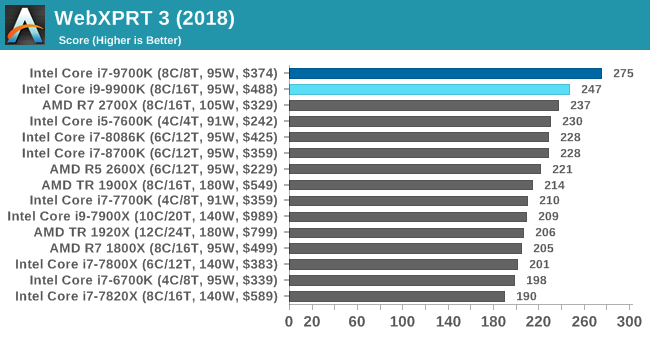
WebXPRT 2015: HTML5 and Javascript Web UX Testing
The older version of WebXPRT is the 2015 edition, which focuses on a slightly different set of web technologies and frameworks that are in use today. This is still a relevant test, especially for users interacting with not-the-latest web applications in the market, of which there are a lot. Web framework development is often very quick but with high turnover, meaning that frameworks are quickly developed, built-upon, used, and then developers move on to the next, and adjusting an application to a new framework is a difficult arduous task, especially with rapid development cycles. This leaves a lot of applications as ‘fixed-in-time’, and relevant to user experience for many years.
Similar to WebXPRT3, the main benchmark is a sectional run repeated seven times, with a final score. We repeat the whole thing four times, and average those final scores.

Speedometer 2: JavaScript Frameworks
Our newest web test is Speedometer 2, which is a accrued test over a series of javascript frameworks to do three simple things: built a list, enable each item in the list, and remove the list. All the frameworks implement the same visual cues, but obviously apply them from different coding angles.
Our test goes through the list of frameworks, and produces a final score indicative of ‘rpm’, one of the benchmarks internal metrics. We report this final score.
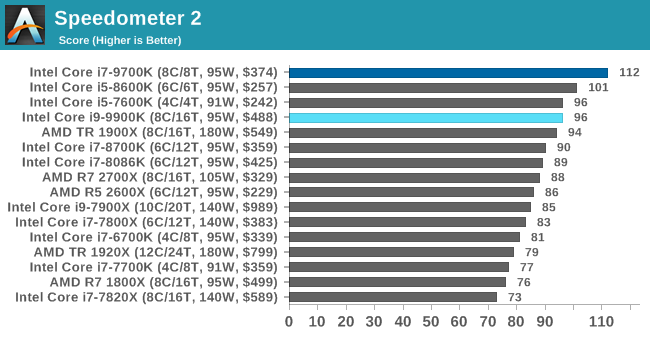
Google Octane 2.0: Core Web Compute
A popular web test for several years, but now no longer being updated, is Octane, developed by Google. Version 2.0 of the test performs the best part of two-dozen compute related tasks, such as regular expressions, cryptography, ray tracing, emulation, and Navier-Stokes physics calculations.
The test gives each sub-test a score and produces a geometric mean of the set as a final result. We run the full benchmark four times, and average the final results.
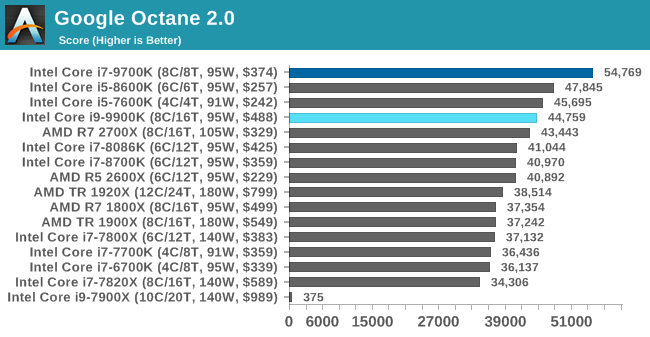
Mozilla Kraken 1.1: Core Web Compute
Even older than Octane is Kraken, this time developed by Mozilla. This is an older test that does similar computational mechanics, such as audio processing or image filtering. Kraken seems to produce a highly variable result depending on the browser version, as it is a test that is keenly optimized for.
The main benchmark runs through each of the sub-tests ten times and produces an average time to completion for each loop, given in milliseconds. We run the full benchmark four times and take an average of the time taken.
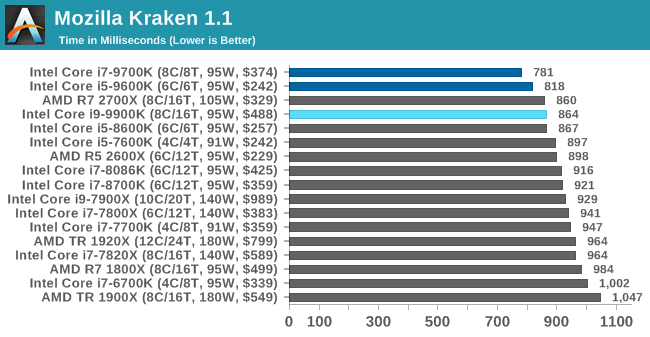
3DPM v1: Naïve Code Variant of 3DPM v2.1
The first legacy test in the suite is the first version of our 3DPM benchmark. This is the ultimate naïve version of the code, as if it was written by scientist with no knowledge of how computer hardware, compilers, or optimization works (which in fact, it was at the start). This represents a large body of scientific simulation out in the wild, where getting the answer is more important than it being fast (getting a result in 4 days is acceptable if it’s correct, rather than sending someone away for a year to learn to code and getting the result in 5 minutes).
In this version, the only real optimization was in the compiler flags (-O2, -fp:fast), compiling it in release mode, and enabling OpenMP in the main compute loops. The loops were not configured for function size, and one of the key slowdowns is false sharing in the cache. It also has long dependency chains based on the random number generation, which leads to relatively poor performance on specific compute microarchitectures.
3DPM v1 can be downloaded with our 3DPM v2 code here: 3DPMv2.1.rar (13.0 MB)
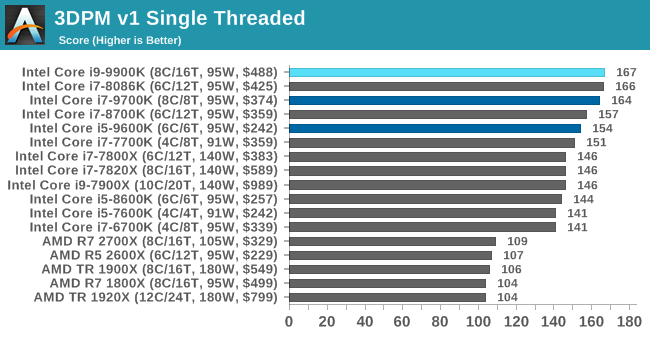
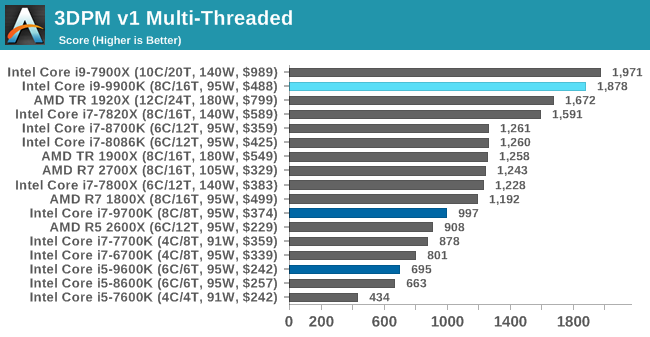
x264 HD 3.0: Older Transcode Test
This transcoding test is super old, and was used by Anand back in the day of Pentium 4 and Athlon II processors. Here a standardized 720p video is transcoded with a two-pass conversion, with the benchmark showing the frames-per-second of each pass. This benchmark is single-threaded, and between some micro-architectures we seem to actually hit an instructions-per-clock wall.
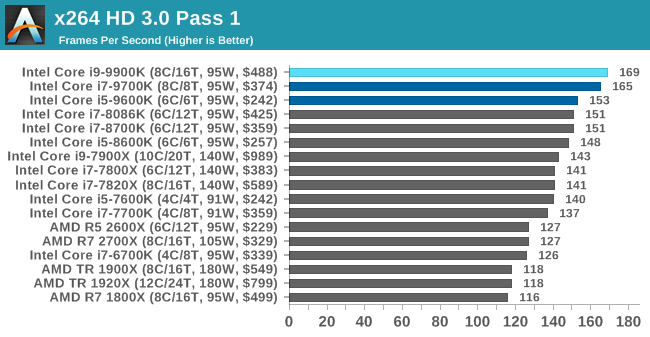
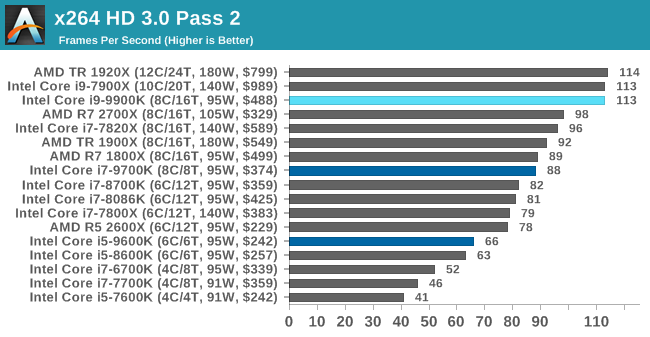










274 Comments
View All Comments
mapesdhs - Sunday, October 21, 2018 - link
The funny part is that, for productivity, one can pick up used top-end older hw for a pittance, have the best of both worlds. I was building an oc'd 3930K setup for someone (back when RAM prices were still sensible, 32GB DDR3/2400 kit only cost me 115 UKP), replaced the chip with a 10-core XEON E5-2680 v2 which was cheap, works great and way better for productivity. Lower single-threaded speed of course, but still respectable and in most cases it doesn't matter. Also far better heat, noise and power consumption behaviour.Intel is already competing with both itself (7820X) and AMD with the 9K series; add in used options and Intel's new stuff (like NVIDIA) is even less appealing. I bagged a used 1080 Ti for 450 UKP, very happy. :)
vanilla_gorilla - Friday, October 19, 2018 - link
So the "Best Gaming CPU" really only has an advantage when gaming at 1080p or less? Who spends this much money on a CPU to game at 1080p? What is the point of this thing?TEAMSWITCHER - Friday, October 19, 2018 - link
Many benchmarks show the 9900k coming "oh so close" to the 10-core 7900X. I'm thinking that the "Best Gaming CPU" is Intel's wishful thinking for Enthusiasts to spend hundreds more for their X299 platform.HStewart - Friday, October 19, 2018 - link
Of course at higher resolution it depends on GPU - but from the list of games only Ashes is one stated not top of class for 4k.If you look at conclusion in article you will notice that most games got "Best CPU or near top in all" which also means 4k CIV 6 was interesting with "Best CPU at IGP, a bit behind at 4K, top class at 8K/16K" which tells me even though it 4k was not so great - but it was even better at 8k/16k
vanilla_gorilla - Friday, October 19, 2018 - link
At 4K every CPU performs at almost the exact same frame rate. Within 1fps. Why would anyone pay this much for a "gaming CPU" that has no advantage compared to CPUs half the price over 1080p? This is insanity.If you are a gamer, save your money, buy a two year old intel or Ryzen CPU and spend the rest on a 4K monitor!
CPUGuy - Friday, October 19, 2018 - link
This CPU is going to be amazing at 10nm.eastcoast_pete - Friday, October 19, 2018 - link
Yes, a fast chip, but those thermals?! This is the silicon equivalent to boosting an engine's performance with nitrous: you'll get the power, but at what cost? I agree with Ian and others here that this is the chip to get if a. bragging rights (fastest gaming CPU) are really important and b. money is no objective. In its intended use, I'd strongly suggest to budget at least $ 2500 -3000, including a custom liquid-cooling solution for both the 9900K and the graphics card, presumably a 2080.In the meantime, the rest of us can hope that AMD will keep Intel's prices for the i7 9700 in check.
Arbie - Friday, October 19, 2018 - link
In the meantime, the rest of us can buy AMD, as anyone should do who doesn't require a chip like this for some professional need.eastcoast_pete - Friday, October 19, 2018 - link
@Arbie: I agree. If I would be putting a system right now, I would give first consideration to a Ryzen Threadripper 1920X. The MoBos are a bit pricey, but Amazon, Newegg and others have the 1920x on sale at around $470 or so, and its 12 cores/24 threads are enough for even very demanding applications. To me, the only reason to still look at Intel ( i7 8700) is the superior AVX performance that Intel still offers vs. AMD. For some video editing programs, it can make a sizable difference. For general productivity though, a 1920x system at current discounts is the ruling Mid/High End Desktop value king.mapesdhs - Sunday, October 21, 2018 - link
The exception is Premiere which is still horribly optimised.